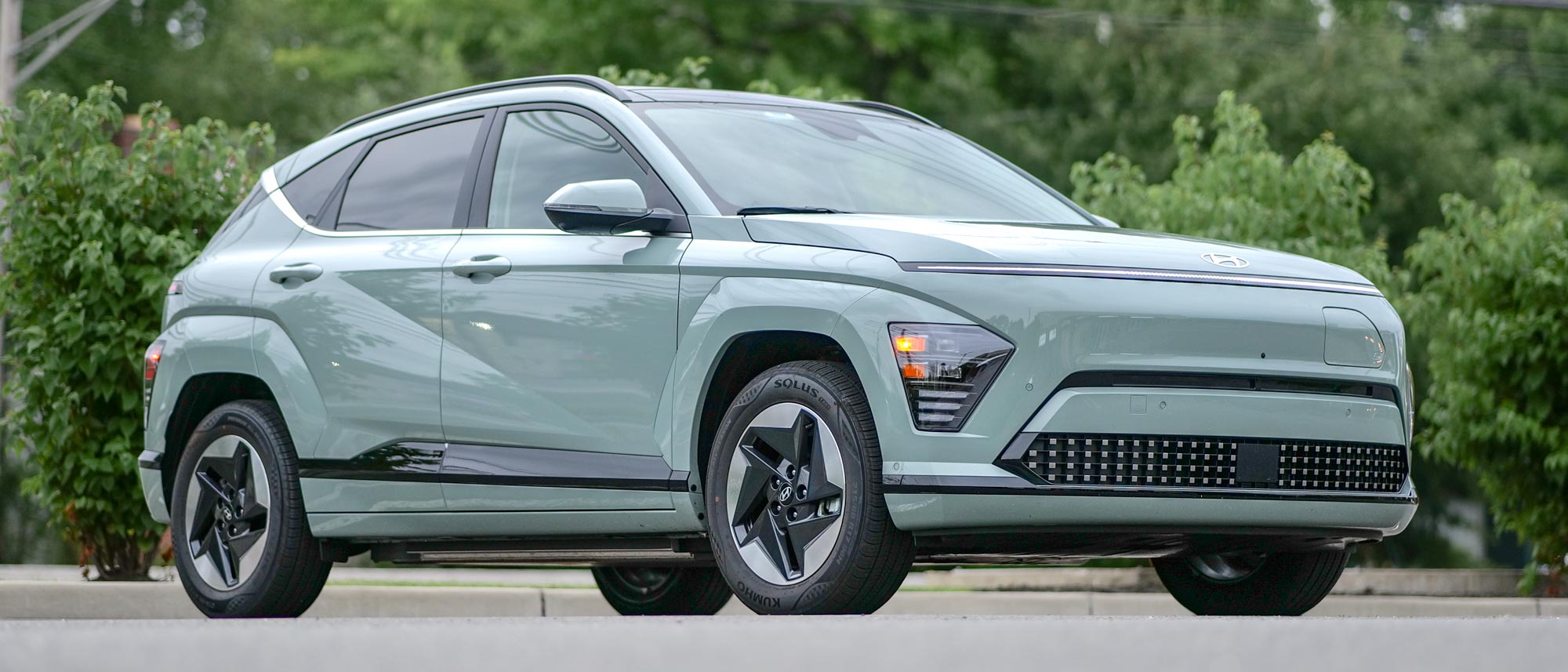I tried charging a Hyundai Kona Electric at home — here's what happened
Level 1 charging is convenient, but you'll wait a long while

One of the EVs that I’ve been test driving of late is the Hyundai Kona Electric. It’s a charming sub-compact SUV that gets my attention largely for its affordable cost, which at an asking price of $33,000 for the base SE model, makes it one of the cheapest electric cars you can buy right now. That balloons up to $42,000 for the Kona Electric Limited trim that I’m test driving, which benefits from having more premium features and a longer range of 261 miles.
Car buyers might be tempted by the Kona Electric, but they need to be aware about the other stuff that goes into buying their first EV. I’m referring to how they’re charged at home, seeing that they might not be inclined to invest yet more money out of their pocket for a faster charger. That’s because depending on where you live, a permit may be required in order to install a Level 2 charger.
While there are certainly greater benefits with a Level 2 charger at home, Level 1 charging is always an option for any new EV owner right from the onset — since it relies on your standard 120V outlet. I charged the Hyundai Kona Electric overnight with Level 1 charging, so here’s what I found out.
You’re looking at several days for a full charge

Using the Level 1 charger that comes with the Kona Electric, it showed a remaining time of 81+ hours before it would get to a full charge from 42%. Unless you work from home primarily, this wouldn’t be feasible — nor would it be good for your electric bill at the end of the month. That’s because chances are your electric rates are substantially higher during peak hours than what they are overnight.
In contrast, a Level 2 charger would take 6 hours and 5 minutes to go from 10% to 100% according to Hyundai. Depending on how much you drive daily, you might not end up having to charge it nightly — which is why Level 2 is the preferred option. Charging on Level 1 with the Kona Electric is the least efficient method of charging, but it’s the most accessible.
Charging range overnight could be enough


Still, that’s my only option at home. When I plugged in the charger, it showed a battery level of 42% with a range of 136 miles. After 10.2 hours of charging overnight, it added back 24 miles of range — bringing up to a level of 50%. That’s a rate of about 0.78% per hour, which would more than likely lessen the closer it gets to a full charge.
It’s roughly 6.2 miles roundtrip for my commute, so the 24 miles of range added back to the Kona Electric I got from overnight charging is more than suitable.
But despite this, that would be more than enough for my daily commute to the train station. It’s roughly 6.2 miles roundtrip for me, so the 24 miles of range added back to the Kona Electric I got is more than suitable for my commute. If your commute is longer, then your best chance at reducing your charging cost would be to go to a charging station during off-peak hours to get the best rates.
Sign up to get the BEST of Tom's Guide direct to your inbox.
Get instant access to breaking news, the hottest reviews, great deals and helpful tips.
With the help of EV charging station apps, you can also find places that charge a fraction of the cost that popular nationwide charging stations offer — like EVgo and Electrify America, which can easily exceed over $0.50/kWh. I ended up finding a charging station that charges at the rate of $0.29/kWh, which is incredible because it was a 62.5 kW charger.
The Hyundai Kona Electric Limited has a 64.8 kWh battery, which would end up costing $18.80 to charge fully from 0% to 100%. If I were to do the same charging at one of the popular nationwide stations, like EVgo, it would end up costing $32.40. Those two totals have a wide margin, which is why it’s important to find charging stations near you that have lower rates.
Nevertheless, you’ll get even better rates at home. With a nationwide average of $0.17/kWh for residential electricity, getting a full charge with the Kona Electric would cost a smidge over $11. While I understand that Level 1 charging is far more accessible, investing in a Level 2 would be the most practical option for long term savings.
More from Tom's Guide

John’s a senior editor covering phones for Tom’s Guide. He’s no stranger in this area having covered mobile phones and gadgets since 2008 when he started his career. On top of his editor duties, he’s a seasoned videographer being in front and behind the camera producing YouTube videos. Previously, he held editor roles with PhoneArena, Android Authority, Digital Trends, and SPY. Outside of tech, he enjoys producing mini documentaries and fun social clips for small businesses, enjoying the beach life at the Jersey Shore, and recently becoming a first time homeowner.
-
rakeshcbhardwaj This hypocrite's review of the Cadillac didn't go into this detail of how long it would take to charge the car. Cadillac added 28 miles overnight while the Kia added 26. Same ballpark yet singing praises for a US car and damning the import. The problem isn't the car. The problem is the US electricity system..120v instead of 240 like many countries. I can FULLY charge my 280 mile range car overnight in 10 hours in the UK. Furthermore since my electricity costs peanuts for 5 hours every night then the cost is negligible. The car isn't the problem.Reply -
USAFRet Reply
US electricity IS 240v. Just that for most outlets, is is split into 2 lines of 120v.rakeshcbhardwaj said:This hypocrite's review of the Cadillac didn't go into this detail of how long it would take to charge the car. Cadillac added 28 miles overnight while the Kia added 26. Same ballpark yet singing praises for a US car and damning the import. The problem isn't the car. The problem is the US electricity system..120v instead of 240 like many countries. I can FULLY charge my 280 mile range car overnight in 10 hours in the UK. Furthermore since my electricity costs peanuts for 5 hours every night then the cost is negligible. The car isn't the problem.
US stoves and clothes dryers run on the 240v line.
While maybe not 'free', it is easy to get a 240v outlet for your car.
But yes, if you connect to a Level 1 charger (120v), it will be slow. -
bjrosen When you buy an EV you put in a Level 2 EVSE, it's a one time cost and it makes your life so much easier. Think of it as as an option for your car. When I got my first Tesla five years ago I bought an 11KW Tesla EVSE for $450 and my electrician charged me $750 to run a 60A 240V line an install it. By way of comparison I just traded in my five year old Tesla for a new one, I splurged on red paint, that cost me $2000. So the EVSE, which I will have forever, cost less than the paint option on the new car.Reply -
UsedToLevel1Charge I think the writer made some kind of mistake; his level 1 charger is running at HALF the normal charging speed. The picture shows he is getting 0.7 kw charge rate, but 1.3 kw is standard when you're plugged into a normal wall socket. I suspect the charger he is using is set to a lower charging rate and he didn't notice.Reply
I had a 2013 LEAF and charged it from a normal wall socket for ten years; you get 50 miles of range, approximately, from an overnight charge. If you don't drive more than 50 miles a day, the Kona should be fine using just Level 1 charging. I have an Ioniq 5 now and still just plug it in to the same wall socket (in fact, I use the same Nissan Leaf charger, which I kept :) ) -
bjrosen Reply
Just to expand on what USAF said. In the US 240V split phase power comes in to the house. The phases are 180 degrees out from each other. Ordinary circuits use a single phase and a neutral which gives us 120V which is sufficient for lamps, it's original purpose, TVs, computers and small appliances. For high power applications like dryers, stoves and EVSEs we use both phases which gives us 240V. The advantage of the US system is that it's safer. Our plugs are much smaller than UK plugs and we don't need switches on our outlets. The advantage of the EU system is that it requires less copper. The historical reason for the difference is that the US got electricity much earlier than the EU. Edison's carbon filament bulb could only handle 110V which is why 110V was selected as the standard, later bumped up slightly to 120V. By the time Siemens invented the tungsten filament bulb the US already had a million buildings that had been wired so it was too late to change. By contrast the number of buildings in Europe and England with electricity was much lower so they just sent everybody new light bulbs and switched to 240.rakeshcbhardwaj said:This hypocrite's review of the Cadillac didn't go into this detail of how long it would take to charge the car. Cadillac added 28 miles overnight while the Kia added 26. Same ballpark yet singing praises for a US car and damning the import. The problem isn't the car. The problem is the US electricity system..120v instead of 240 like many countries. I can FULLY charge my 280 mile range car overnight in 10 hours in the UK. Furthermore since my electricity costs peanuts for 5 hours every night then the cost is negligible. The car isn't the problem.
The EU/UK also have three phase power in the home, in the US three phase is only used in commercial buildings and factories. Because of three phase power the max sized EVSE is 22KW in the EU vs 19.2 on the US, this doesn't matter at all for cars because their chargers are generally 7.2KW to 11KW. It does matter for trucks which have much larger batteries and higher power chargers. -
ZuliMuli Reply
This was the most confusing part to me, on a 15amp circuit you should see 3-4 miles an hour easy.UsedToLevel1Charge said:I think the writer made some kind of mistake; his level 1 charger is running at HALF the normal charging speed. The picture shows he is getting 0.7 kw charge rate, but 1.3 kw is standard when you're plugged into a normal wall socket. I suspect the charger he is using is set to a lower charging rate and he didn't notice.
I had a 2013 LEAF and charged it from a normal wall socket for ten years; you get 50 miles of range, approximately, from an overnight charge. If you don't drive more than 50 miles a day, the Kona should be fine using just Level 1 charging. I have an Ioniq 5 now and still just plug it in to the same wall socket (in fact, I use the same Nissan Leaf charger, which I kept :) )

